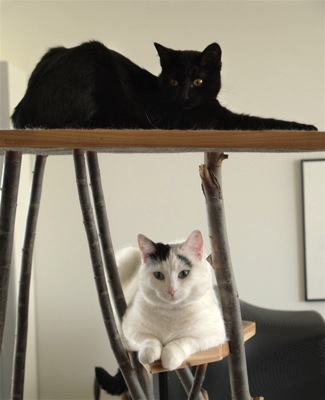Joel has pointed out this interesting thread about
a "hypothetical" moral dilemma caused by editioning photographs. We keep going back and for on whether we should have limited edition prints of Joel's
art photography and the discussion there raises some interesting conundrums. Go, read, I'll wait here.
As you know, Bob, the discussion is about when the "mistake has already been made". Early prints were limited to 10---10! The mind boggles. We were talking about 100. But this limiting was also the size of the original print run, in which case: wow, 10 prints at once. That must have hurt the pocketbook.
At any rate, the photographer's gallery insisted on limited editions and the number 10 was chosen. Decades go by. The early work of this photographer rises in after-market value. One of the early editions goes for over $3 million on auction. The losing bidder approaches the photographer and asks for a new print to be made for $3 million. What would you do?
The comments obviously split between yes and no, but besides that, they split between "this is a question of integrity", "this is a question of contract", and "I don't know what these terms mean." With
yeses and
noes in each of those camps.
Legally, there's the question of contract. Legally, what was actually agreed to (through "common understanding" or through actual document) needs to be looked at. But even if I knew contract law backwards and forwards and were confident I was within my legal rights to print this new one, that still wouldn't prevent me from being taken to court and paying the resulting legal fees. So legality is only partially relevant. Perception-of-illegality matters almost as much. And frankly, I have no idea what either would be in this case.
At least some of the commenters think it's so obviously a matter of integrity that it doesn't even need to be explained. "Integrity is priceless", they say. Or "For $3 million? I'll trade integrity for that." But what kind of integrity, at what point in the story is it so obviously about integrity? Why is it so clear to them and so muddy to me? Is it the promise, that you made a moral contract to stick to 10 prints? In that case, what were the terms of the moral contract? That seems as muddy to me as the details of a legal contract. I don't know what you, the gallery, and the buyers were agreeing to back then.
A sub-class of the "question of integrity/contract" people think this is a moot point, because that print run exists and was limited, and a new print run will involve different technologies, cropping, size, editing, and date. Thus it is a new creation, and the limitation on the original run is intact. I'm not including them in the "what does this word mean" camp because they have a very clear idea of what the words mean. But their definitions are not universal.
Which brings us to the last camp, the "what means 'limited edition' anyway?" This is a sticky matter indeed, especially when we do single prints at a time.
I can more-or-less understand print runs when you have an original source (even a negative or digital file or a lithographic plate) and you do multiples at a time. There is physically a reason this picture is labeled "2 of 10, 1979 print run". Fine. And even limiting it makes sense if it is possible you no longer own the original source. You got the prints made, you sold the original painting, there is a physical limit on the work. Until copyright runs out and prints can be made at whim, of course. And we're relying on the integrity and self-interest and the legality of the owner of the original, that they should not make prints. Since you own the copyright and they own the artifact, I think it stays moderately clear.
But all the procedures for limiting the print runs of photos, where it seems awfully silly to get rid of the source, seem arbitrary. We have talked about limiting the number. And numbering the prints. And now, dating the prints. But what counts? Using the print for a lamp? An 8x10? What about dramatically different printing processes?
This is ridiculous. These decisions are entirely arbitrary and there's not even agreement within the community of what the terms "should" mean. Integrity and breaking the terms of the social and legal contract seems to be an "I know it when I see it" thing rather than something clearly laid out. Because this is not how art works any more. Even painters can keep the digital scan of their original on file---and probably should, because it is THEIR work and the copyright remains theirs.
There is no way we, personally, can afford to do multiple-print runs. We've gotten duplicates of 2"x3" prints for cards. That's it. Every other print is a run of 1. The size and cropping changes, the colour-correction changes, the printing changes, the printER changes. How could we decide how many print runs were appropriate? And what sizes counted? We don't have the words for this.
This is an issue for me because it does matter---I understand it mattering---that someone who buys one of Joel's prints has reasonable assurance it's not going to pop up everywhere. They have a work of art, not a stock photograph. The scarcity is part of the charm. But there is a natural source of scarcity: us. He manages every print run. He signs every print. We cannot scale up to IKEA or Walmart levels of duplication. You do have the guarantee of the personal touch, the connection with the artist, the limited scope. But I can't promise that over the decades there won't be 11 prints out there, or 101, or 1001 unless we make that arbitrary (and breakable) promise.
It's hard to imagine getting up to 100 without getting heartily sick of that particular print. But it's also hard to imagine a print go for $3 million at auction when you make it possible to special-order one for a few hundred dollars. I don't mind. And maybe someday someone will want to buy the rights. And if he agreed, Joel would hand over the electronic copies and the editing history and remove all trace of it from his files and backups and decide on his own terms what it was worth and what it required to maintain integrity on that deal. But in the mean time, if you want a print, have at 'er.
If there were a word for that we'd be set.
The problem is not just that I don't have a word for what I think we should do, but that we the community don't know what anyone means by "limited edition". But many people think they do. Including when they have contradictory definitions.
What's a photographer to do?












